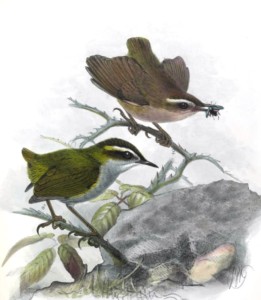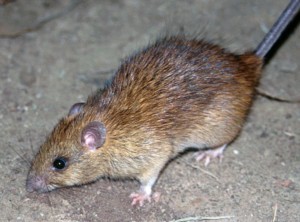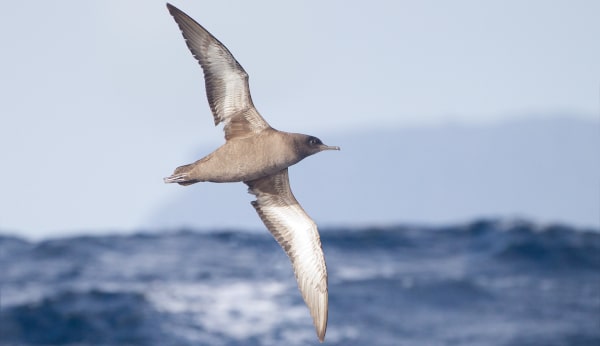LINKED BOOK
The Unburnt Egg. More Stories of a Museum Curator. Gill, B. 2016. Wellington, Awa Press.
Big South Cape Island (940 ha), off the southern tip of Stewart Island, is a “mutton-bird” island where Sooty Shearwaters (Puffinus griseus) nest in burrows. Local Maori families visit in autumn to kill the large downy nestlings (mutton-birds) in a traditional food harvest. In the 1960s, the island was covered in low forest and largely unmodified except for the huts of the 25 or so mutton-birder families. It was a refuge for rare land birds like the Bushwren (Xenicus longipes) because the island was free of predatory mammals, including the Ship or Black Rat (Rattus rattus) that reached New Zealand as a pest on sailing ships and began to spread in the 1860s.

Figure 1 Hand-coloured lithograph of male (lower) and female Bushwrens (Xenicus longipes) by J.G. Keulemans (from Buller, W.L. 1873 A History of the Birds of New Zealand. 1st ed.) | CC0
In 1955 a scientific party trapped one Ship Rat on Big South Cape. This must have been an isolated individual because the mutton-birders saw no damage to the soap, candles and bags of flour that they left exposed in their huts. It seems that more rats reached Big South Cape Island in the early 1960s. In autumn 1963, a mutton-birder at the north end noticed that potatoes in his hut had been chewed by rats. Next season, damage by rats was more widespread and in March 1964 first news of the problem reached the Wildlife Service in Wellington. The officers sent to investigate found the bird-life and large insects in the north of the island greatly depleted. Rat poison was laid to delay the spread of the rats but soon they were everywhere and many species of birds declined. South Island Robins (Petroica australis) and New Zealand Fernbirds (Poodytes punctatus) quickly died out.
The Wildlife officers transferred some birds of the rarest species from Big South Cape to nearby rat-free islands in August and September 1964. Six Bushwrens were caught for transfer to Kaimohu Island (8 ha) but it was difficult to keep them in captivity and three died. In a final push, three more were caught and a rendezvous for next morning was arranged with HMNZS Mako, a Royal New Zealand Navy fisheries protection launch. The story takes a heroic turn. Seas were too rough for a dinghy to land on Kaimohu. Instead, the launch attempted to nose up in the swell towards a rocky shelf. Brian Bell, leader of the Wildlife Service party, jumped ashore. Boxes containing the wrens were landed by running them from the boat along a taut line and Brian set the wrens free in the nearby scrub. To get back he attached the line to his life-jacket, jumped in the cold swell and fought to stay afloat until he was hauled aboard.
Bird translocations were a new idea then, and the work was pioneering and experimental. Wildlife officers were back on Big South Cape Island in February 1965 but could find no wrens for transfer. Two wrens were seen on Kaimohu in 1972 but an inspection in 1977, and subsequent visits, revealed none. It is clear now that these were the last Bushwrens and their disappearance signaled the end of the species. The rat plague on Big South Cape Island also exterminated the South Island Snipe (Coenocorypha iredalei) and New Zealand Greater Short-tailed Bat (Mystacina robusta).
The Ship Rats must have reached Big South Cape Island along the mooring lines of fishing boats or the boats of visitors to the island including the mutton-birders. The island was rodent-free when Ship Rats arrived so there were no competitors. There were also few predators of rats besides a large rail (Weka, Gallirallus australis) and an owl (Morepork, Ninox novaeseelandiae). The explosion in Ship Rat numbers on the island was an “irruption”. As the first rats multiplied and spread south, the island would have been to them a paradise with abundant food and few privations. Ship rats adapt to whatever food is available. In New Zealand forests they will eat fruits and seeds, plant shoots, insects, snails and lizards. Ship rats are competent climbers and can reach birds’ nests in tree cavities or towards the ends of outer branches. They eat birds’ eggs up to 60 mm long, and nestlings. Sometimes they catch and kill small adult birds on the nest.

Figure 2 Ship or Black Rat (Rattus rattus) | CSIRO | CC BY 3.0
Ship Rats can breed at 3−4 months old and produce 5−8 young in a litter with multiple litters per year. Under the favourable conditions on the island the initial rat population would have begun to increase exponentially. A chessboard has 64 squares. If you place one grain of rice on the first square, two on the second, four on the third, eight on the fourth, 16 on the fifth, and so on, then this doubling exemplifies a form of exponential growth. It’s easy at first, and everything seems manageable, but it soon becomes a nightmare. On the 21st square you need to place more than a million grains of rice. You need more than a million million grains for square 41, and there isn’t enough rice on the planet to complete the last squares.
Very soon the whole of Big South Cape Island would have been swarming with rats and there was nowhere else to spread. Horizontal surfaces in the huts of the mutton-birders were fouled with rat droppings and rats were nesting among their bedding and inside their mattresses. Besides birds the largest and most accessible kinds of insects were now scarce. Fallen berries had all been eaten, certain kinds of highly palatable plants were defoliated and any edible seedlings on the forest-floor were chewed to ground level. The tide was turning, and under pressure of extreme rat numbers the island was changing from a paradise for the rats to a hell-hole.
The rats were exceeding the ecological carrying-capacity of the island. Nature’s feed-back mechanisms now increased, in proportion to the problem, to correct the overshoot in rat numbers. As hunger prevailed, the rats would have been in poorer condition than before, living shorter lives, and reproducing less productively. The fewer litters of fewer offspring would have contained many sickly young. At peak density the rats would have been in constant contact, with high levels of aggression and fighting. Stress hormones would have been at unhealthy levels and presumably there was cannibalism. High rat numbers would have allowed any infectious diseases and transmissible parasites quickly to run rampant through the whole population. In the huts, the desperate rats stripped wallpaper off the walls to eat the flour paste.
Rat numbers then crashed cataclysmically. But some rats survived. As the vegetation recovered and the species of animals that had not been eliminated multiplied again, rat numbers would have increased. This time the rat population remained in equilibrium with the degraded resources on the island. It would need a sudden availability of a new food-source to trigger another irruption. Finally, a modern poisoning campaign saw rats eliminated from Big South Cape in 2006.
The events on this island show in microcosm what happened several times across the whole of New Zealand as native birds faced the arrival and spread of new predatory mammals brought by Maori and European settlers. But the island is more instructive than that, because the events mirrored what is now happening over our whole planet. More people are alive today (7,260 million souls) than the sum of all who ever lived in the past. Only 4% (by weight) of the planet’s mammals are wild—we and our livestock and pets make up the other 96%. The weight of our poultry is about three times greater than the weight of all the world’s wild birds. By 2050, plastic in the ocean will out-weigh fish. People are doing to the planet what Ship Rats did to Big South Cape Island. The Earth, like Big South Cape Island, is a piece of territory of finite size able to support only so many people and which imposes a limit to human numbers and their economic growth.
Some put faith in technology to solve all problems linked to burgeoning human numbers. Realists doubt that human ingenuity can cope when it would have to produce the required innovations at an accelerating rate—indefinitely. A surer path would be to stabilise our numbers, and then allow them to fall, while organising a static or shrinking, circular, regenerative economy.
Western leaders still seek economic growth—they just don’t get it. Compounding growth in consumption of resources cannot be sustained in a finite world. Economic growth will have to stop sometime; meanwhile it destroys the natural world and threatens our survival. Our proliferation is both unsustainable and as sadly pointless as an irruption of rats. The story of Ship Rats on a New Zealand island is a parable for the world that shows how and why this is so.
Further reading
Bell, B.D. 1978. The Big South Cape Islands rat irruption. Pp. 33–40. In: Dingwall, P.R., Atkinson I.A.E. & Hay, C. The Ecology and Control of Rodents in New Zealand Nature Reserves. Wellington, Department of Lands & Survey.
Merton, D. 2004. The legacy of Big South Cape Island. Forest and Bird 313: 32–35. VIEW
Bell, E.A., Bell, B.D. & Merton, D.V. 2016. The legacy of Big South Cape: rat irruption to rat eradication. New Zealand Journal of Ecology 40: 212–218. VIEW
Image credit
Featured image: Sooty Shearwater, Puffinus griseus | J.J. Harrison | CC BY-SA 3.0






